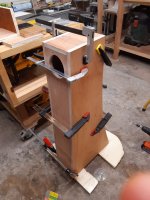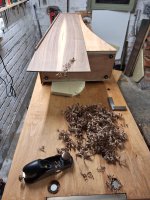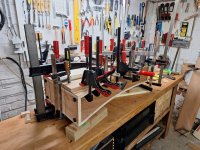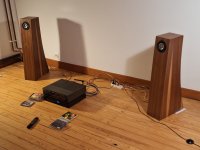As Dave says 'Damp Duct' is what has been known for decades as 'mass loading' -I'm not quite sure why a new term has been introduced. 
Be that as it may, doing as Nandappe recommends completely changes the entire design function, and removes almost all of the purpose behind it. The general result with a high output impedance amplifier is to lower Fb, over-damping the bottom end while doing a minor amount of reduction in the octave above; as Dave points out, the usual solution which was built into the design assumptions is simply to add a little extra damping material. Ideally, you'd also select a drive unit that matches the amplifier load characteristics anyway e.g. one of the Fostex units if you have a high output impedance amplifier although that isn't always possible.

Be that as it may, doing as Nandappe recommends completely changes the entire design function, and removes almost all of the purpose behind it. The general result with a high output impedance amplifier is to lower Fb, over-damping the bottom end while doing a minor amount of reduction in the octave above; as Dave points out, the usual solution which was built into the design assumptions is simply to add a little extra damping material. Ideally, you'd also select a drive unit that matches the amplifier load characteristics anyway e.g. one of the Fostex units if you have a high output impedance amplifier although that isn't always possible.
An interesting comparison of different languages & how terms translate (or not). For contrast, 'mass loading' as a term in the west dates to RCA / Olson & the 1940s, when he created the first MLTL, and arguably the mid 1930s in a different context. It appears in non-audio contexts before that of course, mostly relating to induction / exhaust design.
Hi Scott,
Regarding audio technology, Japanese audio magazines do not write articles on topics that are not profitable.
Since there are almost no foreign specialized magazines translated into Japanese, Japanese builders who only read audio magazines filled with advertisements lack knowledge.
I would like to encourage Japanese builders to participate in this forum as much as possible.
Regarding audio technology, Japanese audio magazines do not write articles on topics that are not profitable.
Since there are almost no foreign specialized magazines translated into Japanese, Japanese builders who only read audio magazines filled with advertisements lack knowledge.
I would like to encourage Japanese builders to participate in this forum as much as possible.
Absolutely -the more the merrier! It would be great to see more Japanese designers / builders here; it's something the forum has (in relative terms) lacked for far too long, other than yourself of course and a few other exceptions.
When I was a teen in the 90’s I designed some exhaust systems for my 2-strokes bikes trying to grab information from GP technical articles on very specific magazines (internet wasn’t there yet). I’ve just got a flash about something I read 30 years ago: a note written on a Yamaha exhaust technical paper about the importance of a restriction and its shape at the end of the convergent cone.It appears in non-audio contexts before that of course, mostly relating to induction / exhaust design.
A friend & fellow member here taught himself horn design to give himself the edge when designing race car induction & exhaust systems. I gather some were successful enough they were banned for being within the letter but not the 'spirit' of the regulations. Adrien Newey would tip his hat as a fellow 'creative' I suspect. 😉 In a minor way, I've done similar, although ran up against an inability to fully remap the then-available engine management.
Most (95%+) of Japanese speaker builders don't do original designs.
They just copy other people's designs or install drivers in kit boxes or finished boxes.
They may be interested in how to build or finish a box, but very few are interested in the design method or theory of operation.
The DIY sections of audio magazines are similar.
I have invited people to join diyAudio forums on several social networking sites where Japanese people participate, but no one seems to be interested.
Tetsuo Nagaoka” is still the god of Japanese builders.
By the way, I was an amateur rally driver when I was young.
There was a time when I made my own exhaust muffler, and I tried various expansion tubes.
Now that I think about it, the expansion tube may have worked similarly to a ducted backroad.

They just copy other people's designs or install drivers in kit boxes or finished boxes.
They may be interested in how to build or finish a box, but very few are interested in the design method or theory of operation.
The DIY sections of audio magazines are similar.
I have invited people to join diyAudio forums on several social networking sites where Japanese people participate, but no one seems to be interested.
Tetsuo Nagaoka” is still the god of Japanese builders.
By the way, I was an amateur rally driver when I was young.
There was a time when I made my own exhaust muffler, and I tried various expansion tubes.
Now that I think about it, the expansion tube may have worked similarly to a ducted backroad.
Rally-prepped Mk1 Micra? Neat. I wish I'd kept some of my Rover 800 pictures; I think I've a few but they're all hard-copy and in a suitcase in the loft somewhere. Great fun on hill-climbs though. That 2.7 Honda V6 was fantastic. 😉
Sure, that's exactly what they are. 🙂 There's a lot of crossover between the fields, especially aero engines and some of the great work done in the US muscle / pony car scene. If you're interested, check out the Olds W-30 or the earlier Mopar long-ram induction setups. Still inspirational 60+ years on.
Sure, that's exactly what they are. 🙂 There's a lot of crossover between the fields, especially aero engines and some of the great work done in the US muscle / pony car scene. If you're interested, check out the Olds W-30 or the earlier Mopar long-ram induction setups. Still inspirational 60+ years on.
Would it be possible for him to share his experience on this forum? I always like to see new applications of existing knowledge.A friend & fellow member here taught himself horn design to give himself the edge when designing race car induction & exhaust systems.
It took me three weeks to build the speakers from plywood and another four months to finish the veneering... But very satisfied with the result! Some pictures of the build proces:Hi, I've just built a pair of almost finished Mk3 Frugel Horns. I say 'almost finished' because the speaker box isn't glued, but screwed together so that I can still make adjustments. The woofers are Alpair-7MS. The cabinets are made from 18mm plywood, and I plan to veneer them with walnut wood.
....




Very nice! Please tell us what the veneer is.It took me three weeks to build the speakers from plywood and another four months to finish the veneering...
jeff
American walnut 🙂Very nice! Please tell us what the veneer is.
jeff
Hi bjgodefr
I built a pair in about 2010 with CHP70's. still listening to them. I see no reason whatsoever to make any others
I started with a chip amp but now have a 5 Watt Class A which I can only describe as having am uncanny 'blackness' between notes, utterly superb combo.
And for those who think 5 Watts is not enough ......... go try it!! 🙂
Cheers - J
I built a pair in about 2010 with CHP70's. still listening to them. I see no reason whatsoever to make any others
I started with a chip amp but now have a 5 Watt Class A which I can only describe as having am uncanny 'blackness' between notes, utterly superb combo.
And for those who think 5 Watts is not enough ......... go try it!! 🙂
Cheers - J
Hello all,
Do I need polyfill in the front section? The plans says "see notes page ix for driver-by-driver" but couldn't find info. Driver is Alpair 7 MS. They will be placed close to the wall and I can't have too much bass as I live in an old apartment. Both my receivers have tone controls so it's not to end of the world.
Other question: you can see the opening at the bottom where the back meets the internal wall is incorrectly angled. I traced my line wrong for my biscuit joints and the V is slightly larger than intended. Had to wedge some wood in between to close the gap.
Will this affect sound negatively?
You can see another mistake: I cut the rebate for the driver on the wrong side of the baffle so I had to fit a piece and glue it.
First one came out perfect but this one i was running on empty.

Do I need polyfill in the front section? The plans says "see notes page ix for driver-by-driver" but couldn't find info. Driver is Alpair 7 MS. They will be placed close to the wall and I can't have too much bass as I live in an old apartment. Both my receivers have tone controls so it's not to end of the world.
Other question: you can see the opening at the bottom where the back meets the internal wall is incorrectly angled. I traced my line wrong for my biscuit joints and the V is slightly larger than intended. Had to wedge some wood in between to close the gap.
Will this affect sound negatively?
You can see another mistake: I cut the rebate for the driver on the wrong side of the baffle so I had to fit a piece and glue it.
First one came out perfect but this one i was running on empty.
That i pretty good.
The amount damping below the driver depends o=in driver, room, position, amplifier, taste all have an affect of the amount required.
Wen only know A7 — a good start is 20g.If you have too much bass, first pull the speaker out further, and it that is inufficient (or not possible) add damping. Reverse if not enuff bass. A high Rout amplifier will tend to require more.
dave
The amount damping below the driver depends o=in driver, room, position, amplifier, taste all have an affect of the amount required.
Wen only know A7 — a good start is 20g.If you have too much bass, first pull the speaker out further, and it that is inufficient (or not possible) add damping. Reverse if not enuff bass. A high Rout amplifier will tend to require more.
dave
@tcpdumpling : try to do what I did. Close the speakers temporarily. Do a listening test and change the filling until you're satisfied.
Hello, I did the same with Blue Tack and stood on it to seal it, surprisingly it worked. Then I ran mine in for a week with a tuner and BBC Radio 3 playing quietly. That was 10+ years ago. My latest is Hiromi Uehara and Rhapsody in various shades of blue very loudly. Great speakers, great performer. Cheers
- Home
- Loudspeakers
- Full Range
- Frugel-Horn Mk3 Builds & Build Questions